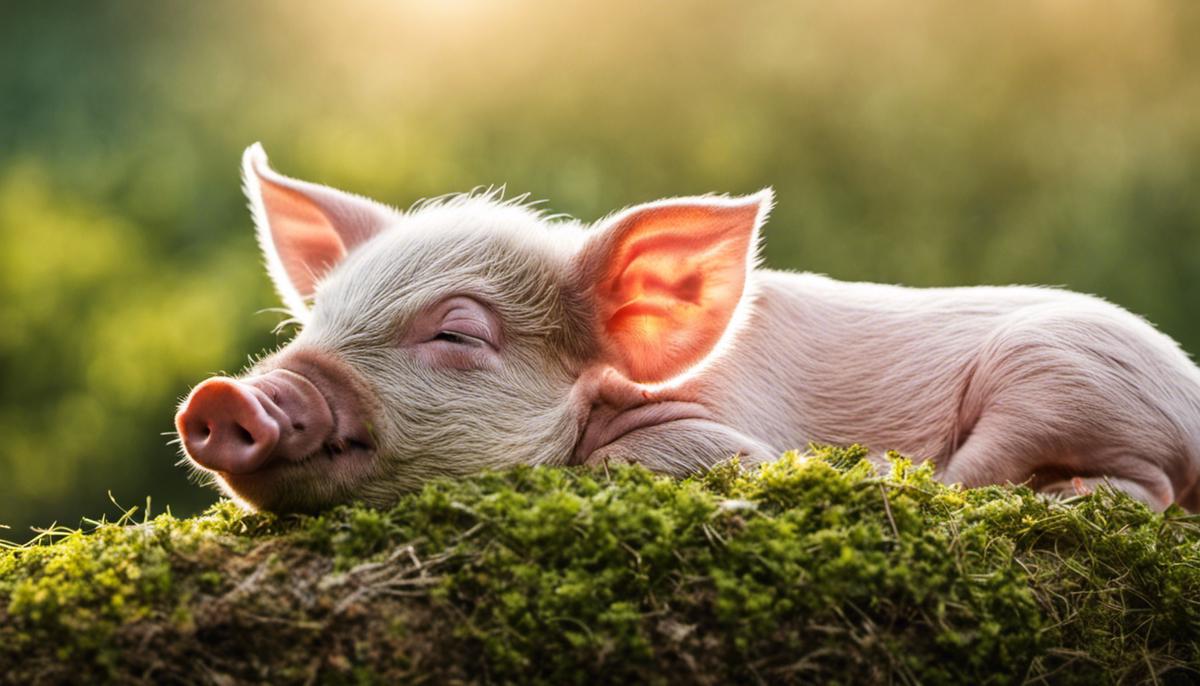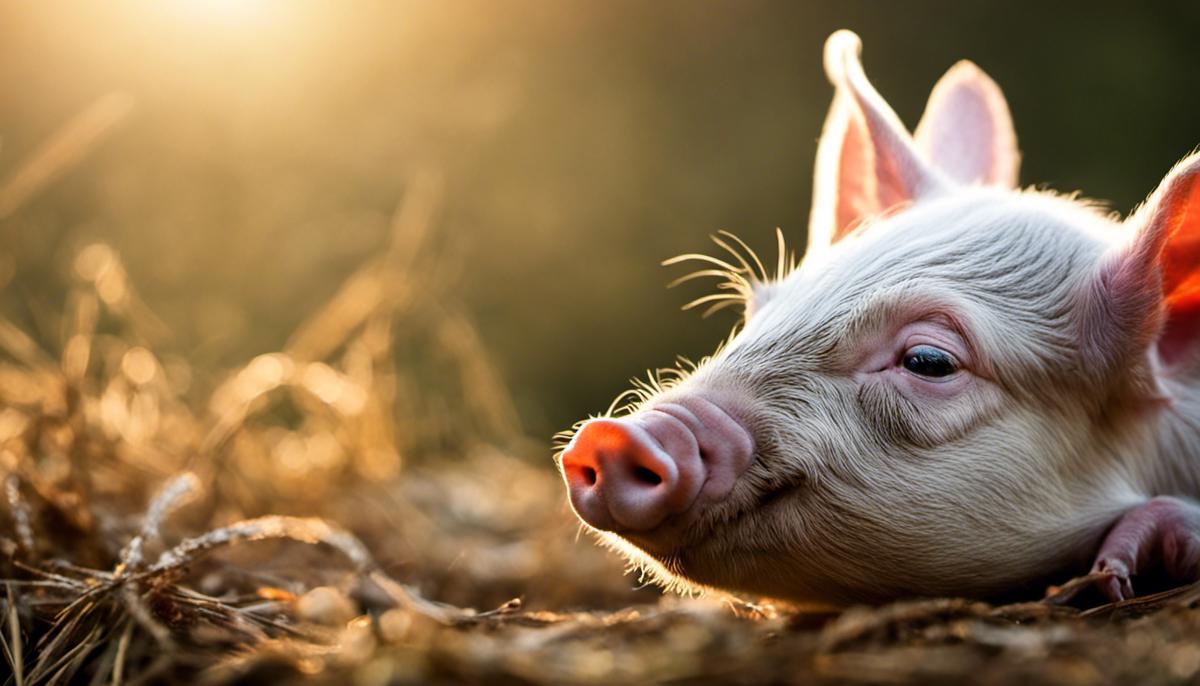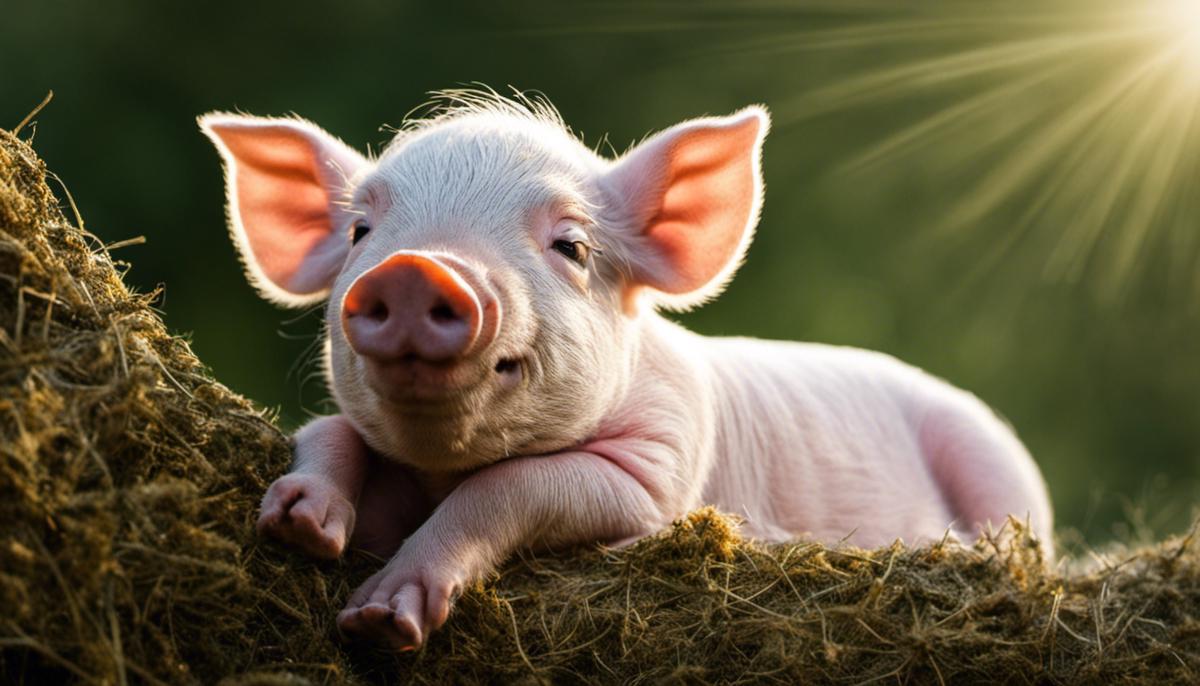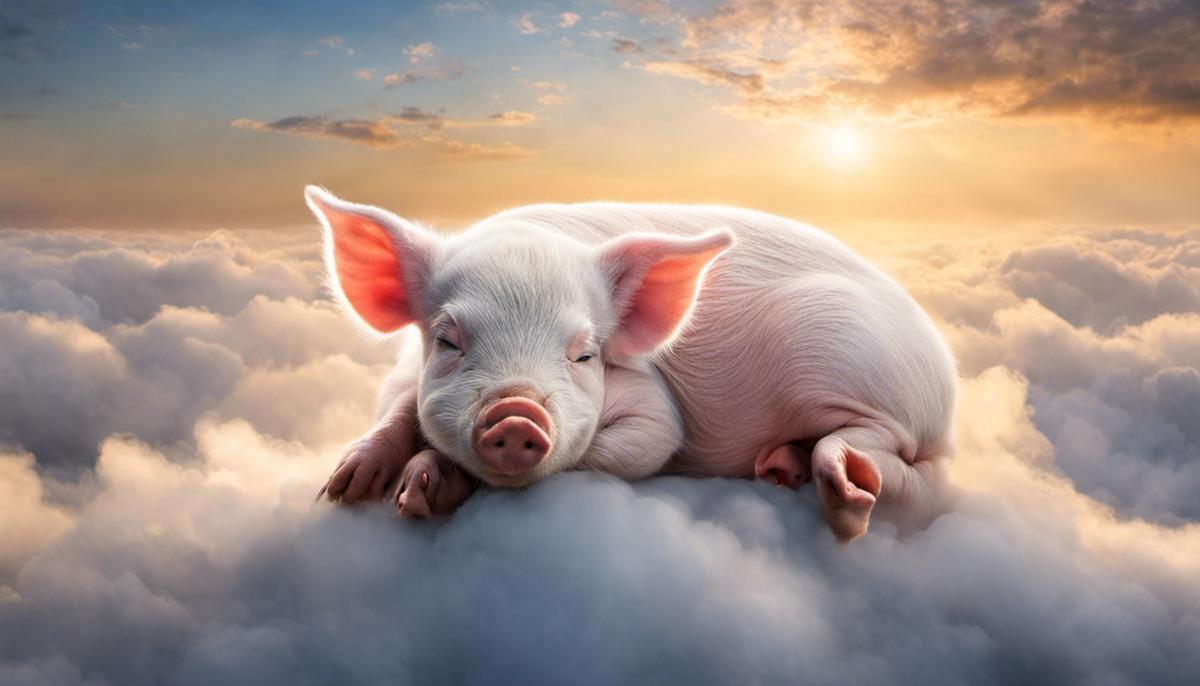The seeming simplicity of a piglet’s life can often shroud the complex cognitive process happening within. One such intriguing aspect pertains to dreams. Yes, dreams! The same confounding, fascinating phenomenon experienced by humans manifests equally, if not more intriguingly, in piglets. The realm of piglet dreams extends beyond the boundaries of adorable cuteness and enters the mysterious regions of brain activity, behavioral manifestations, and environmental influences. This exposé takes you on an enlightening journey through the maze of understanding mammalian dreams, the interpretation of piglet dream behavior, the impact of their environment and experiences on their dreams, and methodologies that help us decipher these dream patterns.
Understanding Mammalian Dreams
Understanding the Enigma of Piglet Dreams: An Exploration of Comparative Mammalian Dream States
A fascinating journey exists in the exploration of the world of dreams, a realm dividing and unitifying not only human beings but the entirety of the mammalian clade. This article aims to shed light on an aspect often overlooked in neuroscientific research – the elusive dream states of piglets, and how they compare to those of other mammals, including humans.
Dream states present a captivating field of study, offering insights into neurophysiology, consciousness, and cognitive processes. In various mammalian species, including pigs, humans, cats, and dogs, Rapid Eye Movement (REM) sleep, associated with dreaming, has been reliably identified.
Classical electroencephalogram (EEG) readings have demonstrated that, during this period, heightened neuronal activity produces perceptual experiences often manifested in the form of dreams.
Neonatal pigs, often referred to affectionately as piglets, are scientifically intriguing as they exhibit REM sleep patterns similar to those seen in human infants. To probe deeper, let’s first understand the common characteristics of mammalian dream states.
Firstly, dreams in mammals predominantly occur during REM sleep, where brain waves resemble those of the awake state, indicating an active brain. This phase is typically characterized by rapid-eye-movements (hence its designation), skeletal muscle atonia, and vivid dream narratives. Interestingly, piglets, much like human beings, show indications of entering the REM state within a few days post-birth.
Secondly, mammals often exhibit physical movements mirroring their dream content. This phenomenon, termed “dream enactment,” is noticeable in dogs paddling their legs as if running and cat movements suggestively representative of hunting. Curiously enough, piglets display twitching whiskers and quick movements of the extremities, indicative of potential dream enactment.
Comparatively, piglet dream states possess several striking similarities to their human counterparts. Like human infants, piglets spend a considerable proportion of their slumber in REM sleep, a figure that somewhat diminishes with age. This increased REM sleep allocation in infancy is postulated to aid neurodevelopment and synaptic pruning, thereby facilitating cognitive maturation.
Furthermore, piglets, much like human beings, present a highly complex cerebral architecture. The presence of a well-developed prefrontal cortex, the seat of higher cognitive functions including episodic memory, suggests the capacity for complex dream narratives much akin to those in humans.
However, while summarizing these observations, it is critical to recall the philosophical dilemma of other minds – the solipsistic conundrum. The only consciousness we can ever truly know is our own. Notwithstanding the paths neuroscience has paved, it is nearly impossible to access the dream world of another being fully. It aligns with the somewhat poignant notion of John Locke’s: No man’s knowledge here can go beyond his own experience.
In conclusion, the investigation into piglet dreams offers an intellectually stimulating delve into comparative neurobiology – an area where the boundaries of human and non-human consciousness blur intriguingly. Further research in this rich paradigm not only brings us closer to comprehending the complexities of neurophysiology but also fosters an enhanced appreciation for the rich tapestry of mammalian life.

Interpreting Piglet Dream Behaviour
Nonetheless, it is crucial to highlight the means by which scientists can draw inferences about the dream experiences of piglets. Observable behaviors are the key to unlocking this knowledge. These behaviors, which offer tangible evidence of the dream state, include subtle physiological changes as well as more noticeable physical movements.
Firstly, an important indicator of the onset of dreaming in piglets is the shift from Non-Rapid Eye Movement (NREM) sleep to Rapid Eye Movement (REM) sleep. This transition is typically marked by a considerable increase in brain wave activity, which can be detected via electroencephalogram (EEG). In humans and other mammalian species, dreams primarily occur during REM sleep, which is also characterized by elevated brain temperature – a pattern that piglets exhibit as well.
Secondly, piglets display distinctive eye movements during REM sleep. While the idea of measuring eye movement might seem straightforward, it requires careful observation. Scientists monitor the piglets’ eyes for a series of rapid, side-to-side motions—hence the term ‘Rapid Eye Movement sleep.’ The eye movements have been associated with visual experiences in dreams, and their presence further attests to the dreaming state.
Furthermore, it’s worth noting the phenomenon of skeletal muscle atonia during REM sleep. Atonia refers to a state of near-complete muscle relaxation, a fascinating paradox given the high level of brain activity during this phase of sleep. Piglets, much like humans and other mammals, exhibit this telltale sign of REM sleep. It’s thought that this muscle paralysis serves to protect the individual from acting out their dreams physically.
Concrete physical movements seen during sleep in piglets can provide additional insights. There have been observations of twitches in peripheral limbs during sleep, which mimic behaviors that piglets might exhibit while awake. These movements seem to correspond with the experiences the piglet is having within its dream. Such physical manifestations of dream content are known as ‘dream enactment behaviors,’ and they provide intriguing glimpses into an otherwise inaccessible realm.
While such observable behaviors pave the way in interpreting the dream experiences of piglets, it’s crucial to acknowledge the limitations of this approach. The subjective nature of dreams can make their interpretation highly speculative. These dreams are encrypted within a personal subconscious language that is, at present, largely indecipherable. Yet that inherent enigma is what spurs researchers onward.
It’s through this diligent work and astute observation that we may uncover more about the dreaming process and its influence on cognitive development in humans and animals alike. In navigating this uncharted territory, we inch closer to comprehending the intricate dance between consciousness and neurophysiological processes. So, while the piglet’s dreaming behaviors might seem small and inconsequential, they may well hold the key to some of the most profound mysteries of neuroscience and cognition.

Influence of Environment and Experience on Piglet Dreams
In examining the intricate dimensions of environmental aspects and life experiences on piglet dream content and frequency, it is imperative to delve into the multifarious factors that impact the dreams of these beings. Though constrained by the inability to directly perceive any sentient being’s mental imagery, utilitarian indicators such as shifts in brain wave activity and eye movement during Rapid Eye Movement (REM) sleep serve instrumental roles in extrapolating potential dream sequences.
The substantial role of an organism’s environment, particularly during its ontogeny, in imprinting neurological markers cannot be understated. Akin to other mammals, piglets experiencing environmental enrichment may yield more frequent and diverse dream states, given the augmentation of sensory inputs to the brain. Such exposures stimulate neuronal plasticity, thereby enriching the neural framework that significantly influences the dream output.
Similarly, traumatic or aversive experiences, akin to stressors endured in deprived conditions, may result in more frequent nightmares or even inhibit REM sleep, and therefore dreaming, altogether. This pervading influence of emotional experiences on dreams is a testament to the pivotal role dreams play in emotional processing, seemingly providing a platform for nocturnal therapy where the day’s experiences are defragmented and archived into cohesive constructs.
Moreover, restrictive environmental conditions devoid of sensory stimuli may result in stunted cognitive and emotional development, potentially leading to less complex dream content. The plasticity of mammalian neuronal structure, particularly in early life, underscores the integral role plasticity plays in dreams’ frequency and content.
The direct environmental impact on piglets’ life experiences ephemerally manifests through dream enactment behaviors, where observed physical activities during sleep allegedly mirror the dream’s content. A piglet prancing around in sleep, for instance, might be a reverie of traipsing through vast fields, navigating mazes, or other locomotor activities experiences during wakefulness. While our comprehension remains bound by observational constraints, it is these minute actions that help unravel the uncharted panorama of piglet dreams.
Moreover, it is crucial to acknowledge that the homologous mammalian dream sequences may also be influenced by internal biological factors such as feeding schedules, light cycles, and hormonal changes—which, while not bearing imminent life histories, recurrently impact the piglet’s body rhythm and sleep architecture.
As neuroscientists continue to scrutinize the piglet’s dreamscape, they unprejudicedly remain aware of the capricious nature of dream interpretation. Respectfully abiding by science’s stringent parameters doesn’t confine their ever-growing curiosity; it merely fuels their endeavor to dissect these nocturnal narratives more rigorously, allowing them to plunge deeper into the neurophysiological abyss. This relentless pursuit seamlessly intertwines their passion for knowledge with an unending fascination with the intriguing and enigmatic world of dreams. The vision ahead may be blurry, but the path is brimming with the promise of profound revelations and intellectual gratification.

Assessment Methodologies for Piglet Dream Analysis
The methodology employed to study dreaming in piglets is a rich tapestry of protocols rooted in neurophysiology, behavioral analysis, and more recently, the integration of cutting-edge imaging technologies.
Electroencephalography (EEG) and electromyography (EMG) have long been the gold standard in sleep research, providing essential clues about brain waves and muscular activity, both key parameters in choreographing the dance of REM and Non-REM sleep stages.
Identification of dream sequences in piglets is primarily based upon behavioral cues tied closely to the REM sleep phase where they display bursts of rapid eye movements.
Further, during this stage, temporary paralysis, also known as atonia, takes effect upon the skeletal musculature, lending a powerful indication towards a dream state, a phenomenon also observed in humans.
In a fascinating development, advanced functional Magnetic Resonance Imaging (fMRI) and Positron Emission Tomography (PET) scan technologies are adding new dimensions to our understanding by offering an unprecedented view of active brain regions during sleep.
This potentially suggests a correlation between specific regions recruited and the imagined scenarios in the piglet’s dream world.
Tracking motor activity during sleep, also termed as dream enactment, provides integral insight into the possibility of piglets physically living out their dreams, although caution must be exercised.
The leap from observing these somatic responses to understanding the exact dream content is vast and currently fraught with scientific limitations.
Our quest to fully grasp the intricacies of piglet dreams necessitates a holistic view of external and internal influences.
Environmental factors, such as interactions with siblings, can undoubtedly etch imprints on their dreams.
Equally significant are sensory inputs responsible for sparking neuronal plasticity believed to enrich dream narratives.
An emerging field of interest is the influence of traumatic or adverse experiences on piglet dreams.
Intriguing research suggests links between exposure to stressful events and nightmares, even inducing inhibitory effects on REM sleep.
Additionally, physiological factors hold sway over the dream landscape.
Feeding behaviors, light-dark cycles, and fluxes in hormones can tune the rhythm and patterns of REM-NREM oscillation, shaping piglet dreams in their wake.
The road to deciphering piglet dreams is riddled with challenges of interpretation and understanding, dictated still by the constraints of human perception.
While it still remains a largely elusive pursuit, our strengthened arsenal of scientific methodologies continues to add ever-expanding layers of depth and nuance to our knowledge.
Undeniably, it necessitates an intending readiness to push the boundaries of our understanding and extend our methodologies beyond existing paradigms.
Thus, the fascinating phenomenon of dreaming in piglets remains at the forefront of probing the mysteries of consciousness, cognitive development, and the very nature of our mammalian existence.

Navigating the winding channels of piglet dreams, we’ve journeyed from the neurological foundations of those dreams, through their behavioral expression, to the influences of environment and experience, and finally, to the methods that study and decode them. Along the way, we have seen the threads that connect these piglet dreams to our own sleep-and-dream patterns. A charming piglet’s dream is not just the frilly narrative of whimsy. Instead, it’s a rich tapestry of cognitive processes that reflects survival instincts, social behavior, learning experiences, and environmental imprints. The examination of dreams doesn’t merely peek into the piglet’s mind. It extends our understanding of dreams in a broader, more encompassing spectrum of psychology across various species, including us humans. Truly, the study of piglet dreams uncovers a fascinating intersection of science, behavior, and environment that will continue to captivate and challenge our understanding in the years to come.
